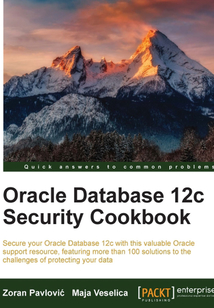舉報 

會員
Oracle Database 12c Security Cookbook
ThisbookisforDBAs,developers,andarchitectswhoarekeentoknowmoreaboutsecurityinOracleDatabase12c.Thisbookisbestsuitedforbeginnersandintermediate-leveldatabasesecuritypractitioners.BasicknowledgeofOracleDatabaseisexpected,butnopriorexperienceofsecuringadatabaseisrequired.
目錄(136章)
倒序
- coverpage
- Oracle Database 12c Security Cookbook
- Credits
- About the Authors
- About the Reviewers
- www.PacktPub.com
- eBooks discount offers and more
- Preface
- What this book covers
- What you need for this book
- Who this book is for
- Sections
- Conventions
- Reader feedback
- Customer support
- Chapter 1. Basic Database Security
- Introduction
- Creating a password profile
- Creating password-authenticated users
- Changing a user's password
- Creating a user with the same credentials on another database
- Locking a user account
- Expiring a user's password
- Creating and using OS-authenticated users
- Creating and using proxy users
- Creating and using database roles
- The sysbackup privilege – how when and why should you use it?
- The syskm privilege – how when and why should you use it?
- The sysdg privilege – how when and why should you use it?
- Chapter 2. Security Considerations in Multitenant Environment
- Introduction
- Creating a common user
- Creating a local user
- Creating a common role
- Creating a local role
- Granting privileges and roles commonly
- Granting privileges and roles locally
- Effects of plugging/unplugging operations on users roles and privileges
- Chapter 3. PL/SQL Security
- Introduction
- Creating and using definer's rights procedures
- Creating and using invoker's right procedures
- Using code-based access control
- Restricting access to program units by using accessible by
- Chapter 4. Virtual Private Database
- Introduction
- Creating different policy functions
- Creating Oracle Virtual Private Database row-level policies
- Creating column-level policies
- Creating a driving context
- Creating policy groups
- Setting context as a driving context
- Adding policy to a group
- Exempting users from VPD policies
- Chapter 5. Data Redaction
- Introduction
- Creating a redaction policy when using full redaction
- Creating a redaction policy when using partial redaction
- Creating a redaction policy when using random redaction
- Creating a redaction policy when using regular expression redaction
- Using Oracle Enterprise Manager Cloud Control 12c to manage redaction policies
- Changing the function parameters for a specified column
- Add a column to the redaction policy
- Enabling disabling and dropping redaction policy
- Exempting users from data redaction policies
- Chapter 6. Transparent Sensitive Data Protection
- Introduction
- Creating a sensitive type
- Determining sensitive columns
- Creating transparent sensitive data protection policy
- Associating transparent sensitive data protection policy with sensitive type
- Enabling disabling and dropping policy
- Altering transparent sensitive data protection policy
- Chapter 7. Privilege Analysis
- Introduction
- Creating database analysis policy
- Creating role analysis policy
- Creating context analysis policy
- Creating combined analysis policy
- Starting and stopping privilege analysis
- Reporting on used system privileges
- Reporting on used object privileges
- Reporting on unused system privileges
- Reporting on unused object privileges
- How to revoke unused privileges
- Dropping the analysis
- Chapter 8. Transparent Data Encryption
- Introduction
- Configuring keystore location in sqlnet.ora
- Creating and opening the keystore
- Setting master encryption key in software keystore
- Column encryption - adding new encrypted column to table
- Column encryption - creating new table that has encrypted column(s)
- Using salt and MAC
- Column encryption - encrypting existing column
- Auto-login keystore
- Encrypting tablespace
- Rekeying
- Backup and Recovery
- Chapter 9. Database Vault
- Introduction
- Registering Database Vault
- Preventing users from exercising system privileges on schema objects
- Securing roles
- Preventing users from executing specific command on specific object
- Creating a rule set
- Creating a secure application role
- Using Database Vault to implement that administrators cannot view data
- Running Oracle Database Vault reports
- Disabling Database Vault
- Re-enabling Database Vault
- Chapter 10. Unified Auditing
- Introduction
- Enabling Unified Auditing mode
- Configuring whether loss of audit data is acceptable
- Which roles do you need to have to be able to create audit policies and to view audit data?
- Auditing RMAN operations
- Auditing Data Pump operations
- Auditing Database Vault operations
- Creating audit policies to audit privileges actions and roles under specified conditions
- Enabling audit policy
- Finding information about audit policies and audited data
- Auditing application contexts
- Purging audit trail
- Disabling and dropping audit policies
- Chapter 11. Additional Topics
- Introduction
- Exporting data using Oracle Data Pump in Oracle Database Vault environment
- Creating factors in Oracle Database Vault
- Using TDE in a multitenant environment
- Chapter 12. Appendix – Application Contexts
- Introduction
- Exploring and using built-in contexts
- Creating an application context
- Setting application context attributes
- Using an application context 更新時間:2021-07-02 16:43:47
推薦閱讀
- 黑客攻防從入門到精通(實戰秘笈版)
- Boost程序庫完全開發指南:深入C++”準”標準庫(第5版)
- C# 2012程序設計實踐教程 (清華電腦學堂)
- Java Web及其框架技術
- Cassandra Data Modeling and Analysis
- Web Application Development with MEAN
- R的極客理想:工具篇
- Oracle Exadata專家手冊
- Windows內核編程
- Python機器學習算法: 原理、實現與案例
- Learning Concurrency in Kotlin
- 智能手機APP UI設計與應用任務教程
- Couchbase Essentials
- 深度學習原理與PyTorch實戰(第2版)
- Zabbix Performance Tuning
- JavaScript編程精解(原書第2版)
- PHP項目開發全程實錄(第4版)
- Python編程基礎教程
- 量子計算機編程:從入門到實踐
- MySQL核心技術與最佳實踐
- 菜鳥成長之路
- Python深度學習與項目實戰
- Learning Swift
- Learning Ext JS(Fourth Edition)
- Learning Akka
- Python商業數據分析:零售和電子商務案例詳解(雙色)
- Zend Framework 2.0 by Example:Beginner’s Guide
- PhoneGap 3 Beginner's Guide
- SAP Lumira Essentials
- 智能風控平臺:架構、設計與實現

